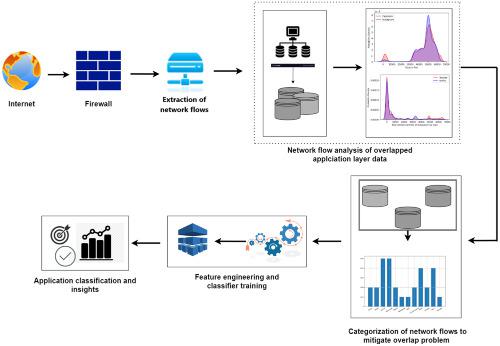当前位置:
X-MOL 学术
›
Int. J. Netw. Manag.
›
论文详情
Our official English website, www.x-mol.net, welcomes your
feedback! (Note: you will need to create a separate account there.)
Application layer classification of Internet traffic using ensemble learning models
International Journal of Network Management ( IF 1.5 ) Pub Date : 2020-11-23 , DOI: 10.1002/nem.2147 Asad Arfeen 1 , Khizar Ul Haq 1 , Syed Muhammad Yasir 1
International Journal of Network Management ( IF 1.5 ) Pub Date : 2020-11-23 , DOI: 10.1002/nem.2147 Asad Arfeen 1 , Khizar Ul Haq 1 , Syed Muhammad Yasir 1
Affiliation

|
Accurate application layer classification of Internet traffic has been a necessary requirement for various regulatory, control, and operational purposes of Internet service provider (ISP). Due to the dynamic and ever evolving nature of Internet applications generating a diverse mixture of Internet traffic, it has been necessary to apply deep packet inspection (DPI) techniques for traffic classification. DPI methods offer accuracy but degrade overall network throughput and thus cause problems in ensuring quality of service (QoS) and maintaining service-level agreements. Moreover, Internet traffic is mostly end to end encrypted. This in turn limits the applicability of DPI techniques and renders them useless, unless the encryption tunnel is broken by the service provider which would risk violating user privacy. To address these trade-offs between classification accuracy, performance, and user privacy, we resort to machine learning (ML)-based algorithms. In this article, we apply three ensemble ML algorithms and report their performance metrics in the application layer classification of Internet traffic.
中文翻译:

使用集成学习模型对互联网流量进行应用层分类
互联网流量的准确应用层分类已成为互联网服务提供商 (ISP) 各种监管、控制和运营目的的必要要求。由于 Internet 应用程序的动态和不断发展的性质会生成各种 Internet 流量混合,因此有必要应用深度包检测 (DPI) 技术进行流量分类。DPI 方法提供准确性,但会降低整体网络吞吐量,从而导致在确保服务质量 (QoS) 和维护服务级别协议方面出现问题。此外,互联网流量大多是端到端加密的。这反过来限制了 DPI 技术的适用性并使它们变得无用,除非加密隧道被服务提供商破坏,这会冒着侵犯用户隐私的风险。为了解决分类准确性、性能和用户隐私之间的这些权衡,我们求助于基于机器学习 (ML) 的算法。在本文中,我们应用了三种集成 ML 算法,并在互联网流量的应用层分类中报告了它们的性能指标。
更新日期:2020-11-23
中文翻译:

使用集成学习模型对互联网流量进行应用层分类
互联网流量的准确应用层分类已成为互联网服务提供商 (ISP) 各种监管、控制和运营目的的必要要求。由于 Internet 应用程序的动态和不断发展的性质会生成各种 Internet 流量混合,因此有必要应用深度包检测 (DPI) 技术进行流量分类。DPI 方法提供准确性,但会降低整体网络吞吐量,从而导致在确保服务质量 (QoS) 和维护服务级别协议方面出现问题。此外,互联网流量大多是端到端加密的。这反过来限制了 DPI 技术的适用性并使它们变得无用,除非加密隧道被服务提供商破坏,这会冒着侵犯用户隐私的风险。为了解决分类准确性、性能和用户隐私之间的这些权衡,我们求助于基于机器学习 (ML) 的算法。在本文中,我们应用了三种集成 ML 算法,并在互联网流量的应用层分类中报告了它们的性能指标。











































 京公网安备 11010802027423号
京公网安备 11010802027423号